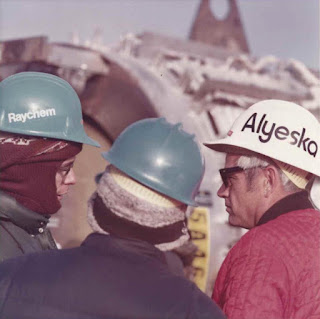“I don't think it's a secret to anyone that the
trans-Alaska pipeline, the terminal at Valdez, is a critical asset not
only to the state but the country. It's stating the obvious - that this
pipeline plays a critical role in this nation's economy.” - Eric Gonzales
 |
| 420 miles of the 800 mile Trans Alaska Pipeline are above ground. |
(The following is one tiny slice of the history of the Trans-Alaska pipeline told by a man who was there.)
The year was 1974 and Alyeska had an incredibly large problem on their hands. Their pipeline had been delayed for years as politicians argued about environmental impact studies, labor disputes and land ownership questions (and probably argued about what was in it for their constituents). At that time, Fusion Bonded Epoxy (FBE) was a somewhat 'new on the scene' pipe coating and manufacturers and applicators were both learning their way through some kinks. In any case, the FBE coated pipe that had been patiently waiting in pipe yards scattered around Alaska had, unfortunately, not been coated with an FBE designed to withstand several years of UV exposure. Imagine that for a second; 380 miles of 48" OD pipe sitting in a pipe yard...and the factory applied coating is experiencing massive failures due to UV degradation. I have to believe this resulted in many sleepless night for those responsible for the integrity of that pipeline.
 |
| The Dalton Highway which runs (at times) parallel to the pipeline. |
 |
| A beautiful partnership is born in 1974. |
Raychem had already been established as a leader in heat shrinkable technology and specialty adhesives. They didn't have the perfect products already created, but they did have a solid base of proven technologies to work from. It was determined early in the process that the timeline for this project needed to be 6 months or less (keep in mind, that was 6 months to production so it would have to include training the different pipeline crews and qualifying the product).
It was also decided early in the process that the best solution was going to be a heat shrinkable, spirally wrapped tape product. Raychem had never manufactured a tape product before! So the team (led by one of the great corporate leaders of all time, Paul Cook) got to work conquering this mountain. The product which was eventually used was called Arcticlad (and was similar to another product called Rayclad that continues to be used today!).
As one team was working on developing and perfecting the Arcticlad, another team was busy engineering the machines that would clean the pipe; preheat the pipe; wrap the Arcticlad and then shrink the Arcticlad. Quite a tall order. Starting at the beginning, machinery was built that encapsulated the pipe and had numerous wire brushes working to knock any lose or disbonded FBE from the pipe.
 |
| The machine at the far right of the picture is the specially designed pipe cleaner. |
 |
| The four silver objects between the two side booms are the heaters. |
 |
| A close up of the wrapping machine, and the Arcticlad pay off. |
 |
| A picture of the finished product. Well done, Raychem! |
As an added bonus, the new technologies Raychem had created to solve this problem were able to be transitioned into entirely new (and leading) product lines. Modern products (currently under the Covalence Seal for Life heading) including ambient temperature wrap around shrink sleeves; factory applied line coatings; closures; road bore sleeves; high temp wrap around sleeves and others can all trace their ancestry right back to the mid 1970's.
One man's problem is another man's opportunity. Isn't that a beautiful thing?
We did a little bit of repair /maintenance on the flex lip dies in bldg A tool control. It's a good feeling to know we were a part of Raychem history in it's biggest project. Bill Holstein
ReplyDelete